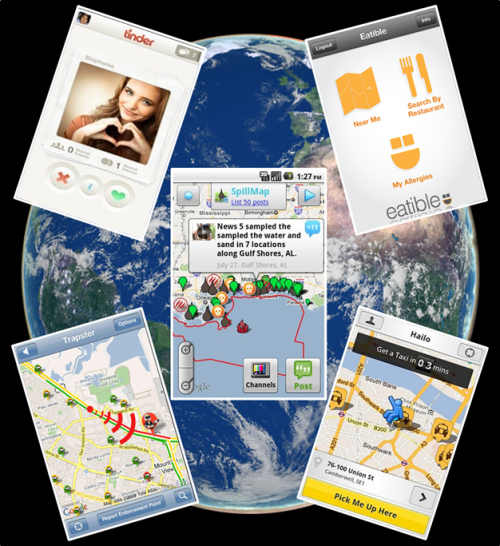We know smartphones are changing the world. It’s made countless everyday tasks easier and saved time and money for its users all around the world. Here is how five mobile apps are changing the way we look at the world. From dating to getting a speeding ticket, these smartphone apps make our lives easier and different one tap at a time.

Tinder – Changing to way we look at dating .
The reputation that Match.com and eHarmony.com hold is that its services are for the middle aged divorcee or single adult who never had much luck at love. But for the college student looking to cast a wider net for potential courters, the traditional online dating websites are too frumpy. That’s where Tinder, the date rating iPhone app, found its niche in October 2012. Tinder works like a “Hot or Not” rating system where users set up a profile and then look at potential dates’ selected Facebook pictures, age, and general location and decide to “like” them or pass them. It allows the user to set the radius of one mile to fifty and once a pair have “liked” each other, both are notified and they can begin chatting. Tinder just became available for Android phones making it easier for a wider net of love birds to break the ice.
Eatible – Changing the way we look at allergies .
Dining with a nut allergy can be especially difficult in a new city or a different restaurant. But like so many other things, a few clicks on our smartphone and problem solved! Users are given the opportunity to indicate their food allergy when making a profile on their Eatible account. Eatible caters to allergies of nuts, soy, wheat, dairy, fish, gluten, and more. Users can set their default location or use the “Near Me” map to find restaurants around them and see the items on the menu categorized by a happy face or sad face. Eatible is moving away from the fast food and constantly working to enter new restaurants into the system. With Eatible, people with allergies can potentially avoid an allergic reaction by knowing exactly what is in their food when they go out to eat.
Trapster – Changing the way we look at traffic tickets .
We know exactly where the speed traps are in our neighborhood and where we need to slow down, but many lead-foot drivers still find themselves driving in fear of being pulled over and receiving a ticket. This is where Trapster has found a niche for itself in the app market. The app doesn’t have any special technology to accurately detect where a cop car is hiding out, but instead the team sits back and lets its users do the work. There are 19 million users on Trapster who have recorded almost 7 million traps using their smartphone. Users are encouraged to help fellow users by marking and voting on designated speed traps and other traffic hazards. Trapster allows drivers to know and mark the nearest live police traps, known enforcement points, red light cameras, speed cameras, electric vehicle charging stations, road hazards, school zones, car accidents, construction zones, and road closures. Users can choose what road conditions they get alerts for and avoid accidents and massive tickets.
Hailo – Changing the way we look at hailing a cab .
What do 14,000 verified yellow taxis in New York City have in common (besides being yellow)? They all work with Hailo, the free cab hailing app launched two years ago after being thought up by three cab drivers and three internet entrepreneurs. Hailo connects cab drivers and passengers when they need to go somewhere. A user simply taps their smartphone screen, the app locates where the user is, and he or she can control when they want the taxi to arrive. Then one of the drivers in the area gets the alert and accepts or declines the pick-up. And better yet, when the driver shows up and notifies the passenger that they have arrived, the fee is paid through the app upon arrival at the destination. Hailo is now available in London, Dublin, Toronto, Chicago, and Boston and is coming soon to Tokyo, Washington D.C., Madrid, and Barcelona.
SpillMap – Changing the way we look at oil spills.
The April 2010 Deepwater Horizon oil spill, better known as the BP oil spill, took the lives of 11 workers onboard, damaged estuaries, and altered the landscape bordering the Gulf of Mexico forever with the 210,000,000 gallon oil spill. But during this time, the public had found it difficult to get full coverage and footage of the spill and that’s where the SpillMap app for Android and Blackberry was able to step in and piece the Gold Coast community back together. On SpillMap, users can create an account online or on their smartphone and take pictures and videos and mark where they were taken on the map. Here, other users can click on the post and see what is going on in certain places. SpillMap gained over 15,000 posts and comments from its many users who participated during the BP oil spill and its aftermath. Even in 2013, there are reports of oil and tar rocks being washed up on Gold Coast shores. SpillMap’s goal is to bring the community together and help efficiently recover from the oil spill.
Advertisement
Learn more about Electronic Products Magazine





